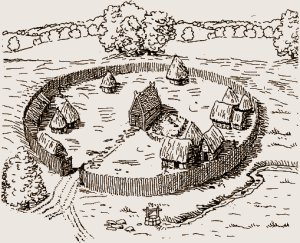St Coca’s Well, Kilcock
Published in St Coca’s Well, March 2001
There are holy wells situated in many parishes in the country and a large number of them pre-date the coming of Christianity. St. Cocas Holy well in Kilcock is one of the ancient wells that is likely to have had its origin in this period.
The ancient holy wells originated in pre-history Ireland as springs that were sacred sites associated with pre-Christian religious activity. The Pagan Irish worshiped water and it is known there were religious gatherings at those springs.
The Christian missionaries on their arrival very wisely decided not to destroy these sites but incorporated some of the ancient activities into Christian religious practices. Many of the older customs were retained and given a Christian meaning. Very often an early Christian Church was founded on or close to the site of a holy well. In about 550 St. Coca, an early Christian missionary founded the first Church in Kilcock in St. Coca’s graveyard. This Church was likely to have been sited close to the spring that was associated with pre-Christian religion in the area. This spring then became Coca’s Well. Following the death of St. Coca an annual pattern would take place at the well on her feast day 6th June and this may have replaced a ceremony probably connected to a pagan cult figure.
The pattern would take the form of pilgrims arriving at the well, drinking its water and walking clockwise around the well a number of times. Prayers would then be offered for cures attributed to the well. Certain festivities would follow such as eating, drinking, singing and dancing.
At the time of the Reformation in 1540 the authorities banned religious ceremonies at holy wells. This ban was strictly enforced in the Kilcock area, which was at that time in the Pale and under the authority of the Crown. However pilgrims would still practice the ancient custom during times of religious toleration.
With the ending of the Penal Laws in the early 19th century, pilgrims continued to visit the holy well. It has been stated that stations used to be held at the well but unfortunately no details of cures survive. Although at this period there was no knowledge of a pattern to the well, the ancient Irish name of the well Tubermococca meaning ‘The Well of Coca’ survived. In the early 1840s the Holy well was closed off to the public but by 1867 a new Parish Church had been built and dedicated to St Coca. So although St. Coca’s well was closed off, her name was continued in the name of the new Parish Church.
Rev. Shearman writing in 1879 gives a description of the location of the well. He stated that the Holy well was ‘in the centre of the town opposite the Brewery gate’. This gate is now the gate between the Credit Union and the Ulster Bank and the location that he was describing is now in the grounds of Scoil Ui Riada. Dr. Comerford Coadjutor bishop of Kildare and Leighlin writing in his collections in 1883 suggested that the holy well was located in an enclosed yard in the town and that the occupant of premises had closed of the well and had the stream coming from it diverted. More information came to light from the Schools manuscripts that were compiled in 1938. These documents pinpointed the holy well as situated in the rear of the Christian Brothers monastery and that the well had been filled in by a previous occupant of that building. According to local tradition in Kilcock a man named Robinson closed off the well. This man was almost certainly Thomas Robinson who according to a survey carried out in 1854 was in possessing of the building that was later to become the Christian Brothers monastery.
In the present time there has been renewed interest in holy wells. A pattern was revived last year to St. Peters well in Donadea on 29th July the feast day of St. Peter. In Kilcock the illustration of St. Coca’s Well has been adopted as the logo of the town and can be seen on the street signs that has been erected on every street in the town. The Icon of St. Coca, which is on display in the Parish Church, shows the saint sitting on the wall of St. Coca’s well. So St. Coca’s well that was a major factor in the foundation of the town continues to have an important role in the local community.
- Schools Manuscript, Kilcock, in Folklore Dept. U.C.D.
- C. O’Donoghue, Holy Wells in Unity in Division, pp 169–179
- Rev.P. Shearman, Loco Patriciana, p.47.
- Rev M.Comerford, Collections Vol II, p.155.
- P. Logan, Holy Wells of Ireland.

